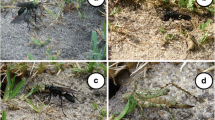Summary
Six mantid species (Sphodromantis viridis, Polyspilota aeruginosa, Hierodula unimaculata, Parasphendale agrionia, Mantis religiosa and Empusa pennata) were studied in laboratory feeding experiments. Mantids stalk their prey and pounce on it, grasping it with their forelegs. Only living prey is selected and it is consumed directly after the catch. The predator orients itself optically, and therefore only takes notice of moving prey. The maximum size of prey which mantids can overwhelm is species-specific and depends on the prey type. On average mantids eat crickets of 50% their own body-weight while cockroaches can weigh up to 110%. Feeding experiments with 101 species of potential prey of 21 invertebrate orders showed an average feeding rate of 70% and marked differences among the predators. Polyspilota proved to be the least specialized mantid and Empusa caught the smallest amount of prey. Most of the defence mechanisms which arthropods have developed against their enemies proved to be ineffective against mantids. Neither a hard chitinous exoskeleton nor poisonous substances prevented the mantids from attacking their prey successfully. The protective secretion of the cotton stainer Dysdercus intermedius proved to be effective at least in a few instances. Even though these bugs were killed, the mantids usually refused to eat the abdomen, where the glands that produce the protective secretion are to be found. Thanatosis, as exhibited by the chrysomelid Cassida viridis and by the phasmid Carausius morosus, proved to be the best protection against mantids.
Similar content being viewed by others
References
Bartley JA (1983) Prey selection and capture by the chinese mantid Tenodera sinensis S. University of Delaware, Dissertation
Barrows EM (1984) Perch sites and food of adult chinese mantids (Dictyoptera: Mantidae). Proc Entomol Soc Wash 86:898–901
Beier M (1934/1935) Mantodea. In Wytsman W (ed) Genera Insectorum, Quatre-Bras, Tervueren (Belgique)
Beier M (1968) Handbuch der Zoologie: 12. Mantodea, 2nd edn. Helmcke, Starck, Wermuth
Berenbaum MR, Miliczky E (1983) Mantids and milkweed bugs: Efficacy of aposematic coloration against invertebrate predators. Am Midl Nat 111:64–68
Calam DH, Youdeowei A (1968) Identification and functions of secretion from the posterior scent gland of fifth instar larva of the bug Dysdercus intermedius. J Ins Physiol 14:1147–1158
Charnov EL (1976) Optimal foraging: Attack strategy of a mantid. Am Nat 110:141–151
Copeland J, Carlson AD (1977) Prey capture in mantids: Prothoracic tibial flexion reflex. J Ins Physiol 23:1151–1156
Eisner T (1970) Chemical defense against predation in arthropods. In Sondheimer E, Simeone J (eds) Chemical Ecology. Academic Press, New York London pp 157–217
Everton IJ, Knight DW, Staddon BW (1978) Linalool from the metathoracic scent gland of the cotton stainer Dysdercus intermedius Distant (Heteroptera: Pyrrhocoridae). Comp Biochem Physiol 63B: 157–161
Gelperin A (1968) Feeding behaviour of the praying mantids: A learned modification. Nature 219:399–400
Holling CS (1964) The analysis of complex population process. Can Entomol 96:335–347
Holling CS, Dunbrack RL, Dill LM (1976) Predator size and prey size: presumed relationship in the mantid Hierodula coarctata Saussure. Can J Zool 54:1760–1764
Hurd E, Eisenberg RM, Washborn JO (1978) Effects of experimentally manipulated density on field populations of the Chinese mantis (Tenodera ardifolia sinensis Saussure). Am Midl Nat 99:58–64
Hurd E, Eisenberg RM (1978) Experimental density manipulations of the predator Tenodera sinensis (Orthoptera: Mantidae) in an old-field community. I. Mortality, development and dispersal of juvenile mantids. J Anim Ecol 53:269–281
Inoue T, Matsura T (1983) Foraging strategy of a mantid, Paratenodera angustipennis S: Mechanisms of switching tactics between ambush and active search. Oecologia 56:264–271
Matsura T (1981) Responses to starvation in a mantis, Paratenodera angustipennis (S). Oecologia 50:291–295
Matsura T, Nagai S (1983) Estimation of prey consumption of a mantid, Paratenodera angustipennis (S) in a natural habitat. Res Popul Ecol 25:298–308
Mitchell AW (1986) The Enchanted Canopy. Secrets from the Rainforest Roof. Fontana/Collins, London
Mook LJ, Davies DM (1966) The European praying mantis (Mantis religiosa L.) as a predator of the red-legged grasshopper (Melanoplus femurrubrum (De Geer)). Can Ent 98:913–918
Nentwig W (1987) The prey of spiders. In Nentwig W (ed) Ecophysiology of spiders. Springer, Berlin Heidelberg New York, pp 249–263
Rossel S (1980) Binocular spatial localization in the praying mantis. J Exp Biol 120:265–281
Wheeler WM (1960) Ants, their structure, development and behaviour. Columbia University Press, New York
Wood SF (1978) Notes on mantids (Stagmomantis, Iris) as possible predators of conenose bugs (Triatoma, Paratriatoma). Pan-Pacific Entomol 54:17–18
Author information
Authors and Affiliations
Rights and permissions
About this article
Cite this article
Reitze, M., Nentwig, W. Comparative investigations into the feeding ecology of six Mantodea species. Oecologia 86, 568–574 (1991). https://doi.org/10.1007/BF00318324
Received:
Accepted:
Issue Date:
DOI: https://doi.org/10.1007/BF00318324




